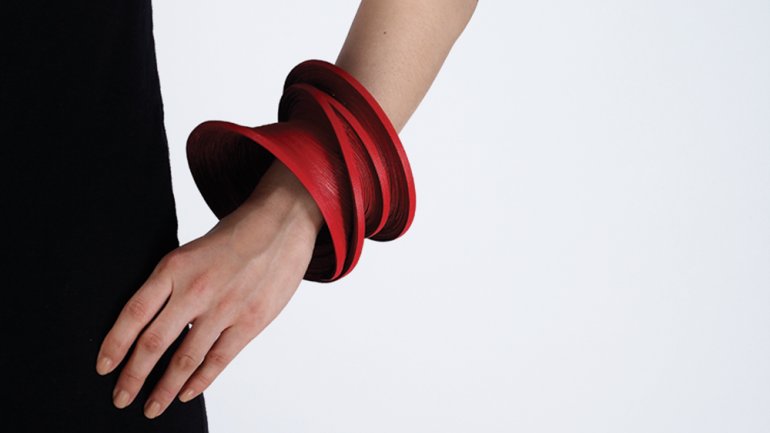One Medium, Many Moves
One Medium, Many Moves
“I find that working directly with materials is the best way to be surprised,” says Yong Joo Kim, a maker of wearable art and sculpture based in Providence, Rhode Island. “That moment of surprise is important for me, because I’m constantly trying to go beyond what I know and what I’m comfortable with.”
For going on six years now, Kim has dedicated herself to pushing the limits of a single material – Velcro hook-and-loop fastener – to create hundreds of complex forms. Though we tend to think of the Velcro brand in terms of sandal straps, diapers, and other everyday uses, in Kim’s hands the humble fastener tape is transformed into extraordinary sculptural neckpieces, brooches, earrings, and bracelets. She cuts, stacks, rolls, twists, and sews it into sensuous curves and subtle gradations of color and surface, artfully exploiting its pliability and the characteristics of its two sides – the rough plastic “hook” and the softer fuzzy “loop.” While she has mostly favored a subdued palette of white, black, and gray, lately she’s been using a deep, dramatic red that she fell in love with on a visit to Velcro USA headquarters in New Hampshire. (The company has been supportive of her work, she says, providing her with access to a full range of raw material.)
Like her pieces, Kim’s career has evolved in ways both planned and serendipitous. She was born, raised, and trained as a metalsmith in Seoul, South Korea, a city with a population of more than 10 million, “where all I could see were people. Busy people. I had a habit of carefully observing their appearances – what kinds of clothes, bags, accessories, and shoes they had.” In 2007, she came to the United States for graduate school at Rhode Island School of Design. In Providence, she recalls, “the streets were empty. It was hard to encounter people. The city was small and rather different from what I was used to. People walked around slowly. So I started to walk slowly as well. As I slowed down, I started to notice things in my environment other than people. I became curious about things I wasn’t interested in before.” Having previously worked only with precious metals and stones, she began to experiment with mundane materials such as nails, beans, cable ties, and straws, “discovering their hidden beauty through a process of reconfiguration.” After graduation in 2009, she settled on hook-andloop fastener as her material because it was cheap and easy to get, and could be manipulated with nothing but hand tools. “The plastic hooks had a sparkling quality, which I was attracted to as well,” she adds.
As she began to develop her techniques and forms, she also started exploring the theories of English psychiatrist William Ross Ashby, a pioneer of cybernetics, the study of complex systems. “In his law of requisite variety, he states that in order to master any problem or process, we have to bring more variety to bear than is inherent in the situation,” Kim explains. Mastery, for her, came to mean an array of skills, an assured response to every occurrence. She likens it to jazz musicians improvising or Ping-Pong players adapting to each shot to stay in the game.
Such insights came in handy when she made a 3-foot abstract wall sculpture exhibited in 2014 in Boston at the Society of Arts and Crafts, which that year gave her its prestigious Artist Award. Originally envisioning a large vessel, she’d spent months cutting and attaching thousands of tiny fastener pieces to build up the shape. To her dismay, it eventually began to slouch with gravity. So she decided to play a little jazz. She embraced this unpleasant surprise and let the shape develop, ending up with a result that was different from her original vision, but equally powerful. “I learned to appreciate how unexpected forms can arise when I deliberately improvise.”
Kim wants to continue working big, as well as branch out into new colors. For now, she’ll be sticking with Velcro as her material and jewelry as her main medium. “Wearable art is unique, because it has mobility. We’re able to wear it and move around,” she observes. What better way for art to perform what she regards as its true function: to unleash potential not just in material, but also in people?
“Art objects in social contexts can empower us,” she says. “To ask questions. To challenge the way we understand the world. To uncover the beauty hidden in everyday life.”

